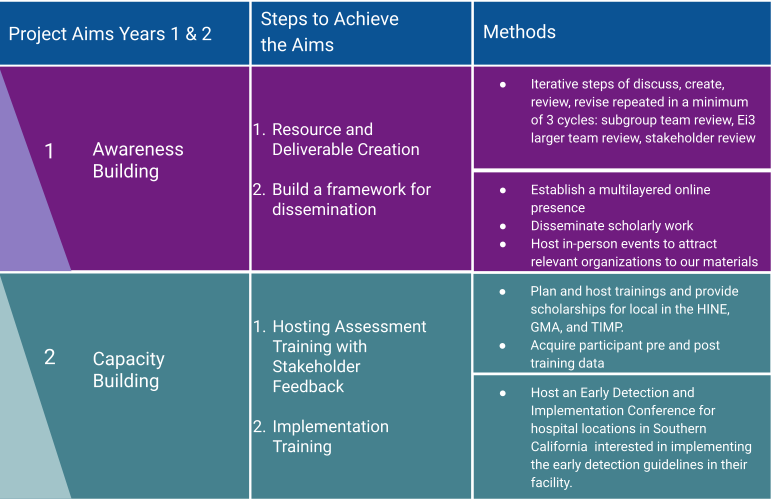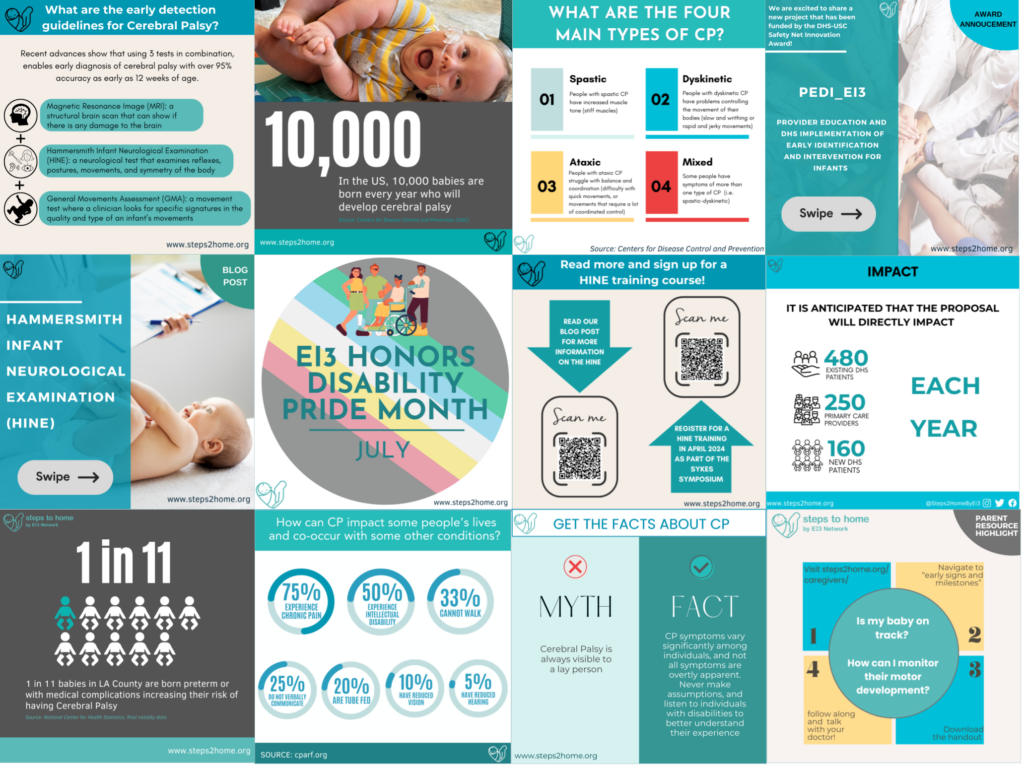
Development and Outcomes of the Early Identification and Intervention for Infants (Ei3) Network
Introduction:
Early diagnosis and CP-specific early intervention are essential for supporting global development of infants with CP and improving long-term outcomes. In 2017, international guidelines were published recommending specific timing and use of standardized measurement tools for the early accurate detection of CP. When healthcare providers follow these guidelines, it allows for infants as young as 3 months of age to be diagnosed with or “at high risk of” CP.
The Early Identification and Intervention for Infants (Ei3) Network is an interdisciplinary team dedicated to improving early detection and intervention of cerebral palsy (CP) in California. A paper was recently published in the Journal of Clinical Medicine that describes the key strategies they have used in their first two years to build awareness of early detection and intervention guidelines, and to build up the capacity of healthcare providers to implement these guidelines.
Why is Ei3 Needed?
While these developments in early identification are encouraging for children with CP and their families, the United States has been slow to implement the guidelines. A lack of coordination across sites, lack of provider training on recommended assessment tools, and differing regulations and definitions across states and counties in the United States may result in these advances in early diagnosis not being universally implemented.
Who is Involved?
The following types of partners and organizations were invited to be involved in the Ei3 Network:
- Research scientists
- Community members (parents/caregivers)
- High-Risk Infant Follow-Up Clinics (physicians, therapists)
- Regional Centers (therapists, service providers and case managers)
- Neonatal Intensive Care Units (physicians, therapists)
- Los Angeles County California Children’s Services (CCS) program representatives
What does Ei3 Do?
The Ei3 network identified two areas to focus on within their first two years: (1) Awareness Building and (2) Capacity Building. Below are highlights of action steps taken for each area.

Building Awareness:
The Ei3 initiative focused on creating educational resources for caregivers, health care providers, and policymakers.
The project developed caregiver-friendly educational handouts in English and Spanish for:
- Risk factors for CP
- Early signs of CP
- How to access to help – with descriptions of the services available through high-risk infant follow-up clinics, California Children’s Services, and Regional Centers
Health Care Provider handouts included:
- Provider Roles and Responsibilities
- Early Detection HRIF Clinic Workflow
- NICU Discharge Template & Medical Eligibility Criteria Summaries
To ensure widespread distribution of information, Ei3 established a multi-layered online presence, academic engagement at conferences, and hosting of in-person events. A website (steps2home.org) was developed with professional branding, content, and integration with a Mailchimp list-serv for updates. Social media channels (@steps2homebyEi3) were created on Instagram, Facebook, X, and YouTube, featuring an introductory video highlighting the team’s mission. The network also participated in academic conferences, including the 2024 Sykes Symposium, and the American Academy of Developmental Medicine and Cerebral Palsy Annual Conference. Other outreach efforts utilized social media, email list-serv blasts, and collaboration with global research networks to promote early detection and intervention strategies.

Building Capacity:
A key barrier to implementing early detection guidelines for CP is the need for widespread training among therapists and physicians on specific assessment tools. To address this, Ei3 organized training sessions and provided scholarships for local care providers to learn important assessments, including:
- Hammersmith Infant Neurological Examination (HINE)
- Prechtl’s General Movements Assessment (GMA)
- Test of Infant Motor Performance (TIMP)
Ei3 co-founder Dr. Dusing, a certified HINE trainer, led multiple free training sessions for hospitals, CCS providers, and clinicians across Los Angeles County. GMA training was also offered following the 2024 Sykes Symposium. Participant feedback was collected after HINE training to assess training effectiveness and its impact on workforce capacity.
In addition to assessment training, Ei3 hosted an Early Detection and Implementation Conference at USC for Southern California hospitals interested in adopting early detection guidelines. Teams of at least three individuals, including NICU and HRIF physicians, therapists, and administrators, participated in real-time implementation planning with expert guidance. The conference included didactic training, structured planning sessions, and team-based strategy development to support changes within their facilities.
In the first two years of its existence, the Ei3 network hosted 11 HINE administration and scoring trainings, reaching 211 providers. HINE training participants reported increased: ability to identify CP, knowledge of and rationale for early detection, ability to implement early detection guidelines, and confidence performing the HINE. Ei3 continues to hold regular HINE trainings and the number of impacted providers is rapidly growing. In addition, 46 people in 2024 and 51 people in 2022 participated in either basic or advanced GMA training, with more training planned for 2025.
Conclusions:
The Ei3 network successfully raised awareness about early detection of cerebral palsy (CP), trained healthcare providers, and gained community support in Los Angeles. Feedback from providers showed that the resources and training helped participants feel more confident in detecting CP early. Involving stakeholders throughout the process made the training more valuable and will help expand the program in the future. The success of this initiative could serve as a model for other groups looking to improve early detection in their own local or regional communities. By implementing these guidelines, infants at risk for CP can receive earlier and better care, improving their long-term outcomes.
Read more about Ei3 in our USC highlight here
Citations:
Butera CD, Yeh A, Biniwale M, Bloch E, Craddock D, Doyle M, Iyer SN, Kretch KS, Liu N, Mirzaian CB, Sargent B, Solano P, Swaine M, Dusing SC. Development and Initial Outcomes of the Interdisciplinary ‘Early Identification and Intervention for Infants Network’ (Ei3) in Los Angeles. J Clin Med. 2024 Dec 6;13(23):7442. doi: 10.3390/jcm13237442. PMID: 39685900; PMCID: PMC11642317.